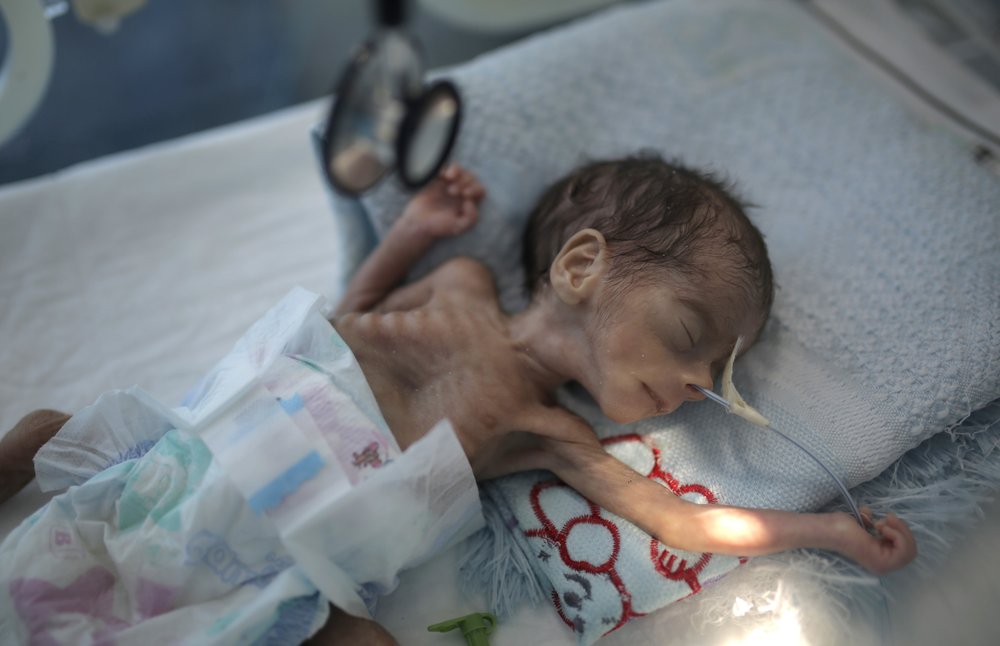
CAIRO (AP) — Millions of children could be pushed to the brink of starvation as the coronavirus pandemic sweeps across war-torn Yemen amid a “huge” drop in humanitarian aid funding, the UN children’s agency warned Friday.
The stark prediction comes in a new UNICEF report, “Yemen five years on: Children, conflict and COVID-19.” It said the number of malnourished Yemeni children could reach 2.4 million by the end of the year, a 20 percent increase in the current figure.
“As Yemen’s devastated health system and infrastructure struggle to cope with coronavirus, the already dire situation for children is likely to deteriorate considerably,” warned UNICEF.
Yemen’s poor health care infrastructure is unprepared to battle the coronavirus pandemic after five years of war between a Saudi-led military coalition and the Iran-backed Houthi rebels. The war, which has mostly stalemated, has also triggered the world’s worst humanitarian crisis.
The conflict erupted in 2015, when the Saudi-led coalition stepped in on behalf of the internationally recognized government, which the Houthis had forced into exile when they overran the capital, Sanaa, and much of the north the previous year.
The situation in Yemen is only expected to get worse as donor countries recently cut back on aid. Yemen has officially recorded more than 1,000 cases of COVID-19, the illness caused by the coronavirus, including 275 deaths. However, the actual tally is believed to be much higher as testing capabilities are severely limited.
“If we do not receive urgent funding, children will be pushed to the brink of starvation and many will die,” said Sara Beysolow Nyanti, UNICEF’s representative to Yemen. “The international community will be sending a message that the lives of children […] simply do not matter.”
UNICEF also warned that unless US$54.5 million are disbursed for health and nutrition aid by the end of August, more than 23,000 children will be at increased risk of dying because of acute malnutrition. It also said that five million others under the age of five will not have access to vaccines against deadly diseases.
International relief agencies are alarmed by the significant decline in humanitarian funding promised earlier by donor countries. A virtual pledging conference for Yemen hosted by the UN and Saudi Arabia on June 2 saw 31 donors pledge $1.35 billion for humanitarian aid — a billion dollars short of what aid agencies needed and half of what countries had pledged in 2019.
UNICEF could only secure 10 percent of the $461 million it appealed for to cover its humanitarian response to the crisis in Yemen, and less than 40percent of the $53 million it needs to handle the impact of COVID-19 on children, said the report.
“UNICEF is working around the clock in incredibly difficult situations to get aid to children in desperate need, but we only have a fraction of the funding required to do this,” said Nyanti.
The UNICEF report came on the heels of a warning by UN humanitarian chief Mark Lowcock who told a closed UN Security Council meeting that Yemen could “fall off the cliff” without massive financial support.
Lowcock added that COVID-19 is spreading rapidly across the Arab world’s poorest country, killing about 25 percent of confirmed cases — five times the global average.
Half of Yemen’s health facilities are dysfunctional and 18 percent of the country’s 333 districts have no doctors. Water and sanitation systems have collapsed resulting in recurrent cholera outbreaks. Around 9.6 million children do not have sufficient access to safe water, sanitation, or hygiene and two-thirds of the country’s roughly 30 million people rely on food assistance.
___
Image: In this Nov. 23, 2019 file photo, a malnourished newborn baby lies in an incubator at Al-Sabeen hospital in Sanaa, Yemen. The UN children’s agency says that millions of Yemeni children could be pushed to “the brink of starvation” as the coronavirus pandemic sweeps across the war-torn Arab country amid a huge drop in humanitarian aid funding. UNICEF on Friday, June 26, 2020 released a new report, “Yemen five years on: Children, conflict and COVID-19.” (AP Photo/Hani Mohammed, File)




